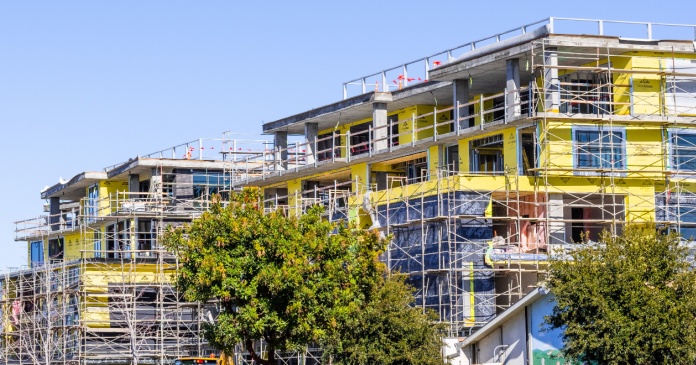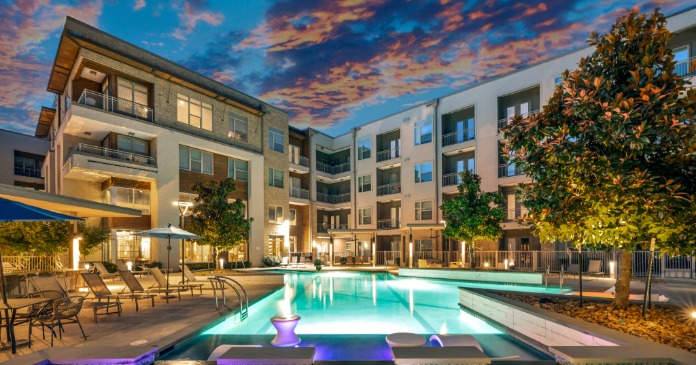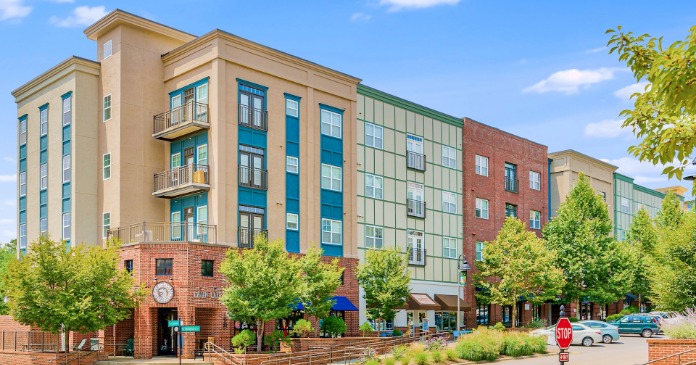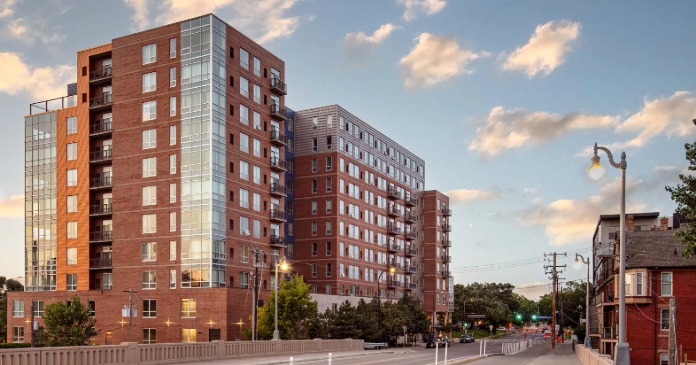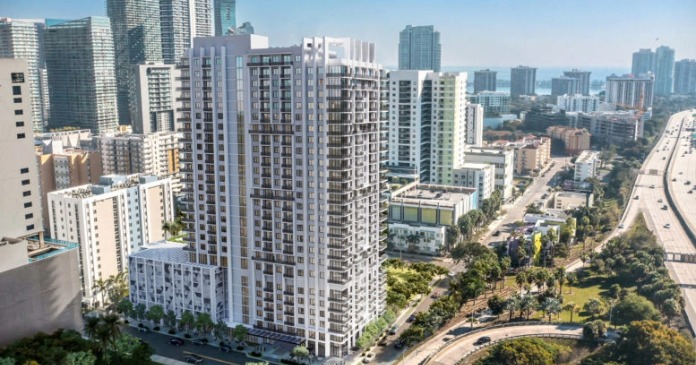Yield PRO TV presents NAHB Power Hitters. Host Linda Hoffman talks with Vaughan Buckley, Chief Executive Officer of Volumetric Building Companies.
Transcript: NAHB Power Hitters interview. Linda Hoffman with Vaughan Buckley, recorded May 5, 2022
(music)
Linda Hoffman: What are you able to build with your blocks?
Castles and palaces, temples and docks.
Rain may keep raining and others go roam,
But I can be happy building at home.
Robert Louis Stevenson’s poem, Block City, written in the 1800s lured many a young mind into the business, present host included. Building is objective. One truth. Brick and mortar. An industry built on axiomatic truths. Case in point. Business does not long tolerate voids. Just as the world’s natural processes go to work to fill a dirt hole, so does business naturally navigate toward filling a market need.
Today’s guest offers an exciting glimpse into a segment of development that has fascinated me for, well maybe from the first time I read Stevenson’s poem. The modular construction market, like all inventions, is an idea that has continued to mature since the 1600s when homes in England were disassembled and shipped to America.
Fast forward through the Gold Rush where homes were assembled in New York factories and shipped to California, and here we are. As with any innovation, we’ve come a long way. Business does not long tolerate vacuums and the market is determined to perfect the modular construction process in order to overcome labor shortages, supply chain delays, achieve economies and more.
Modular construction is projected to reach a market value of $115 billion by 2028. Here today to give us an insider perspective on modular housing within the apartment space is Vaughan Buckley, CEO of Volumetric Building Companies. Vaughan welcome to the show.
Vaughan Buckley: Pleasure to be here, Linda. Thanks for having me.
Linda Hoffman: What do we need to know about your company, VBC?
Vaughan Buckley: I think the easiest way to think about VBC is vertical integration. We provide services from concept to keys. So, land entitlement, architecture and engineering design services through to manufacturing of modular components, transport and installation. So really soup to nuts services. Although all of them are available à la carte, we perform some of our best operations when we can get into a project at the concept stage and see it through to completion.
Linda Hoffman: Many of our viewers have never been involved with a modular project. What must they know?
Vaughan Buckley: Yeah, I think that the easiest way to think about modular projects is to separate them from some of the other off-site construction opportunities that we all use every day like HVAC, you know parts that are produced in the factories and then sent to the jobsite. Modular construction really just takes a lot of those components and aggregates them together. You know, I think the simplest analogy that explains this is Lego blocks. Each apartment is a Lego block and they’re installed together to create a single cohesive building.
So we produce entire apartments or in the case of hospitality, hotel rooms or student housing dorm rooms in a single module and they’re delivered to the site and installed to create a building.
Linda Hoffman: “Factory-built” housing comes in two types: wall panels and three-dimensional modules. VBC uses three dimensional. Why is that?
Vaughan Buckley: Yes. I think that the question really comes down to what problem you’re solving. So, two dimensional panelization of buildings is a really efficient method to produce structure. Right? You produce walls, the floors, ceilings. Things that may be hard for you to produce in the field—either you can’t get a labor or you can’t find the quality that you want or you need it done really quickly and panelization is a great use for that.
Where three-dimensional volumes sort of change the world in relation to off-site manufacturing is that we add all of the other labor and skilled trades into the module, as well. So while 2D might help you with structure, i.e. your framers; it doesn’t help you with your plumbing, your electrical, your flooring, your finishing, your painting, your sprinkler system, or your HVAC. Once you add those complexities, a module is much more complete.
So our apartments are being delivered 80 or 90 percent complete and, really, only having connection work done in the hallways. And that’s a big difference from the two-dimensional world.
Linda Hoffman: The inherent difficulty with factory-built modules is stock-piling the completed modules and transporting them to the construction site. How have you solved this issue?
Vaughan Buckley: I won’t say that we solved it, but I’ll say there are many minds working on resolving it. And the way that we feel it’s best approached is with a cohesive solution. When somebody wants to work with modules it can become very overwhelming. They have a factory to hire, they have to find someone who’s going to move it with trucks, somebody who will set it with cranes, and somebody who will finish it in the field. By combining those services into a single company you allow your customer to buy a product from you instead of the service. And I think that’s really where we differentiate.
Linda Hoffman: I mentioned shipping homes across the country in the opening. That was a far different time. In today’s space and time there’s a practical limitation on the distance your modules can be shipped. How do you deal with that?
Vaughan Buckley: Yeah. I think there’ a couple different ways that you can even deal with it, and some of them are market driven and some of them are logistically driven. So the market might say, for example, that you can ship 2,000 miles before it doesn’t make sense economically. That doesn’t mean that you have enough trucks to move 300 modules 2,000 miles away a piece. You know, you put the rough math into that and you say, okay, that’s 600,000 trucking miles to get those modules to where they need to go and then you need to bring the trailers back. So now it’s 1.2 million miles. Add to that a few escort cars and you’re over a couple of million miles of transport to make a project move.
So that’s where you start to get into logistical limitations. So what I find is when you balance those two things, you balance the market and you balance the logistics, your best to locate your modules within one day’s drive of your facility. That allows you to turn your trucks, your trailers, your equipment and your people in a way that allows them to have the most comfort and the most efficiency.
So most of our factories are located within one day’s drive of the markets they’re serving.
Linda Hoffman: Many of your modular projects contain site-built components—beyond the foundation. Is this typical and what building elements are included in the site-built component?
Vaughan Buckley: Yes. There’s a few different ways to approach this and VBC looks at it a little differently. We talked a bit earlier about how we have this product mentality, right? We want our clients to receive something, i.e. a building. We don’t want them to receive modules. So the difference there is that we think about the building as a system. It’s not just components that put it together. So we like to build, for example, our elevator shafts and our stair towers inside the building and inside our modules. A lot of others will build them separately. They’ll site-build components that include stairs, elevators, anything that’s unique in the building. They’ll want to build that on-site.
We tend towards the other direction. We want our client to receive a product, so we want to build everything we can into the modules. There’s always going to be site-built elements. The foundation as you noted, the façade is usually on-site as well. Roof connections and utility connections are always going to have to be done on site. But the more that we put into the modules the better service we can provide our customers and the closer we can shift our industry towards that product mentality.
Linda Hoffman: You recently sold your module manufacturing factory in North Carolina and purchased a Katerra factory in California that builds cabinets, trusses and panelized building components. Does this indicate a change in direction for VBC?
Vaughan Buckley: It doesn’t. It’s an expansion for us. So we are transitioning out of our North Carolina facility to relocate to a Pennsylvania facility. But that facility in North Carolina is still operating and will be throughout the majority of the year. So we actually just closed on our newest facility, so we can announce it here, in Pennsylvania, in Berwick. We just purchased a factory, formally the Deluxe, an I-built facility up there and we will be now running our modules out of our Pennsylvania factory, as well.
The reasons this brings us back to that last question about being within one day’s drive of your customers—North Carolina is simply too far away to appropriately service Philadelphia and other states in a market where trucking and logistics has tightened so much of the last two or three years. We need to locate closer to our clients.
So we’re doing the same thing in California. We used to ship modules from Pennsylvania all the way to Colorado and now, having a West Coast factory allows us to serve the markets that we’re in. So it’s an expansion in product. It’s an expansion in services. And it’s an expansion in location. But it is not a change in direction.
Linda Hoffman: Well speaking of expansion, VBC recently merged with Polcom, a Polish company specializing in steel-frame modular construction for hotels. How will this merger affect your U.S. business?
Vaughan Buckley: So the US business is now a global business. It’s headquartered in Philadelphia and the Polish entity is operationally managed and controlled from here, in Philadelphia, where I am today. So our headquarters and our strategic leadership is U.S.-based. And we have the Polish operations producing components in hotels for the U.K. market, Scandinavia and even the Middle East.
Linda Hoffman: I know there are many benefits that compress time to market and create other efficiencies in modular. Give us a few that builders should consider when choosing modular.
Vaughan Buckley: I think that there’s a few and it all depend on where your building as to which benefits are most important to you. In urban environments like L.A., San Francisco, New York, Philadelphia, Washington, D.C., our benefits are present in both time and in cost. You know, in those environments where local labor is very difficult to come by and also very expensive, we can be a more efficient and cost-effective product. However, no matter where you build, we are always going to save time and that’s the most consistent function across all of our markets is that we’re going to be about half the time. And we’ve proven this over and over again. It’s always nice to build a project across the street from the same size project, one with off-site construction and one with on-site construction. And just to see the difference.
So we are almost always half the time and that’s because we’re able to be building the modules in a factory at the same time somebody is working on the foundation in the field, which is simply impossible to do you’re constructing on-site because you have to have the foundation before you put anything on it, right? So that’s where our big difference comes into play. And when we’re talking about the crisis around the U.S. right now for housing and shortage that we’re facing, getting twice as many houses built half time is a big deal.
Linda Hoffman: Assets aren’t exposed to the elements as they are in traditional building methods. This makes a difference in the resilience of an asset.
Vaughan Buckley: When you think about the site construction project, often times you’re building the structure first—the wood frame of the building or the steel frame of the building. And then you’re trying to get to weather-in. You know, you’re trying to get your exterior façade or you’re trying to get a roof to make sure the rest of the building doesn’t continue to get wet.
In a factory, we’re never going to get wet, so we don’t have the same goal. So we start with what’s going to take us the longest to build, which is usually the interior finishing, which means that the first day you have a modular construction project on the factory line, it’s painted because that takes the longest. So it’s a completely different way of thinking about construction. We do it in a sequence that is efficient to manufacture, not efficient to weather protect. And that makes a big difference in the time and amount of hours it takes to finish a project.
Linda Hoffman: Well, Vaughan, we appreciate your ingenuity at filling in American’s most pressing void, housing. Great show.
Vaughan Buckley: Thanks so much for having me.
Linda Hoffman: Thank you for joining us today. We value your time and work to provide valuable content that will elevate your business and make it more profitable. If you succeed, our country succeeds.
Stable housing is key to a stable nation built at the hands of private industry compelled by market principles; good housing is of immeasurable value to a nation. Some things will never change. Until next time, I’m Linda Hoffman for NAHB Power Hitters.
(music)
NAHB Power Hitters in association with NAHB, National Association of Home Builders, Building Homes, Enriching Communities, Changing Lives.
Yield Pro TV, an Image production.
Host Linda Hoffman
Executive Producer Andrew Nicks
Research Michael Rudy
Guest Selection and coordination Den Schwanke
Production Image
Yield Pro TV is a production of Multihousing Professional magazine corporation and may not be reproduced or copied in whole or in part without the expressed permission of the publisher.
© 2022 YIELD PRO LLC



